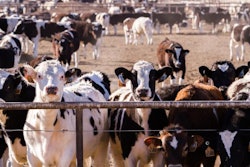
During times of cereal shortages, rice byproducts can be used in a balanced ration
Rice is a global staple food. According to the Food and Agriculture Organization of the United Nations (FAO), about 90% of the world’s rice is produced and consumed in the Asia-Pacific region. Nevertheless, production of rice is significant locally in many other parts of the world. This last aspect has regained importance as the Western world is facing a difficult time ahead regarding cereal prices and availability due to global geopolitical issues.
Unlike other cereals, rice is grown in wet fields (paddy fields). As such, the product harvested is called paddy rice. The brownish kernel of rice is enclosed rather tightly in two interlocking hulls. The ratio of hulls to brown is about 20%. The processing from paddy rice to white rice (the form suitable for human consumption) leaves several byproducts, some of which are more valuable than others:
- Paddy rice is almost never used in animal feeds, and especially not in commercial feeds. The main reason is that rice is a valuable commodity for humans and is therefore almost always processed into white rice. In addition, as we will discuss below, rice hulls are rather unsuitable for animal consumption. Any off-spec paddy rice is most likely also unsuitable for animal consumption, especially if it is moldy.
- The separation of rice hulls leaves behind what is called brown rice. Rice hulls is an undesirable raw material for all animal species because they contain high levels of silica. Rice is the only cereal that actively absorbs silica from the soil, perhaps as a mechanism of resisting certain diseases. Nevertheless, this silica makes hulls very abrasive to the point they can cause lesions if consumed at large enough quantities. More likely is their use for broiler litter, for which they make an excellent absorbent material. In some countries, rice hulls are used in limited quantities in ruminant feeds, mostly in feedlot cattle, when other roughages are lacking or to reduce feeding cost.
- Brown rice is then pearled, often after being mixed with calcium carbonate to remove the outer layers, leaving behind unpolished white rice and rice bran (with extra calcium). Rice bran is rich in fiber, but it also contains sufficient protein, lipids and even some starch to make it an interesting raw material. It is especially rich in certain vitamins, unless it is from parboiled rice, in which case it is the white rice that ends up with these vitamins. The only real problem with rice bran is that lipids can rapidly become oxidized because rice bran contains high levels of the enzyme lipase. If this endogenous enzyme is neutralized, or if rice bran is solvent extracted to remove bran oil, then the resulting product is rather stable. Rice bran can be used more freely in diets for ruminants, to replace other similar products (such as wheat bran), and more restrictively for monogastrics. In the latter case, feeds should be formulated on crude fiber levels to ensure feed intake is not restricted due to excess feed volume.
- The pearled rice is then polished. Rice polishings are practically starch, with remnants of bran. They are rarely sold as such because they are invariably added back to rice bran to enrich it. The end product is often called rice mill run or rice mill feed or just rice bran (uncharacterized product that is difficult to use without end-user laboratory analyses).
- Broken rice, or rice brokens, is fragments of paddy or white rice that are produced during the whole process. These fragments are removed before the final product is deemed suitable for human consumption. Broken rice is more likely to be sold separately and, indeed, certain quantities reach even Europe and beyond. It is recommended to grind rice brokens before including into animal feeds because unground broken rice is likely to exhibit reduced nutrient digestibility, especially for species such as pigs, and less likely for poultry and ruminants. However, this has to do with rice variety (some are harder than others and have disparate starch component ratios), and with the final inclusion level of rice brokens in animal feeds.
In general, processing paddy rice to white rice has an efficiency of 70%. That is, for every 100 kg of paddy rice, we end up with 70% white rice (that includes also brokens). Of the remaining 30%, the part that can be used in animal feeds is only 10%, as hulls make up 20% of the total. That 10% of raw materials suitable for animal feeding can be separated into 8% bran and 2% polishings. The exact ratio is different according to the machinery used, and is also different among rice varieties.
As broken rice is often sold separately and is already used as animal feed, it is the rice bran portion along with polishings that are of main interest as a replacement for cereals during times of shortage. Here, ensuring quality is high and rice bran is stabilized for oxidation, it is the nutrient profile of rice bran that determines its inclusion level in animal feed. As the bran portion of the kernel contains high levels of pentosans (non-starch polysaccharides) it may be beneficial to add a suitable exogenous enzyme to enhance its energy availability.
Finally, feeding brown or even white rice in animals is totally acceptable, always in a well-balanced ration. Brown rice should follow the guidelines that concern wheat bran to ensure certain species are not receiving excess fiber. On the other hand, white rice can be used in all animal feeds, again, according to its nutrient profile.
As white rice is poor in thiamin (a B vitamin), enriching white rice-rich diets with this vitamin is recommended. In fact, this is a major issue for human populations that consume rice as the main part of their diet, and several methods of enriching white rice with thiamin are being practiced. Lack of thiamin causes the well-known disease beriberi.















